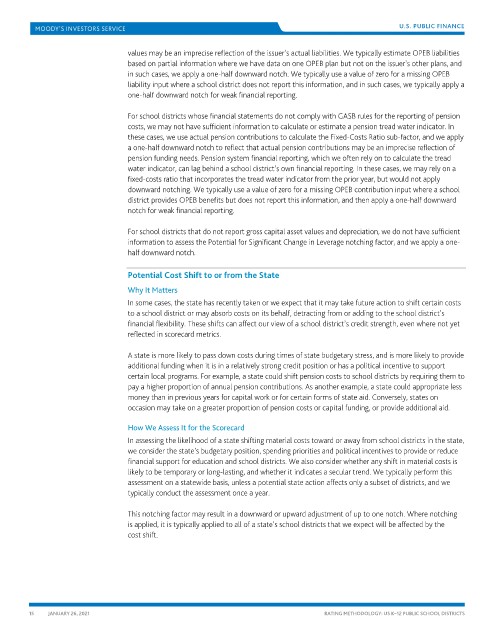Page 1649 - draft
P. 1649
U.S. PUBLIC FINANCE
values may be an imprecise reflection of the issuer’s actual liabilities. We typically estimate OPEB liabilities
based on partial information where we have data on one OPEB plan but not on the issuer’s other plans, and
in such cases, we apply a one-half downward notch. We typically use a value of zero for a missing OPEB
liability input where a school district does not report this information, and in such cases, we typically apply a
one-half downward notch for weak financial reporting.
For school districts whose financial statements do not comply with GASB rules for the reporting of pension
costs, we may not have sufficient information to calculate or estimate a pension tread water indicator. In
these cases, we use actual pension contributions to calculate the Fixed-Costs Ratio sub-factor, and we apply
a one-half downward notch to reflect that actual pension contributions may be an imprecise reflection of
pension funding needs. Pension system financial reporting, which we often rely on to calculate the tread
water indicator, can lag behind a school district’s own financial reporting. In these cases, we may rely on a
fixed-costs ratio that incorporates the tread water indicator from the prior year, but would not apply
downward notching. We typically use a value of zero for a missing OPEB contribution input where a school
district provides OPEB benefits but does not report this information, and then apply a one-half downward
notch for weak financial reporting.
For school districts that do not report gross capital asset values and depreciation, we do not have sufficient
information to assess the Potential for Significant Change in Leverage notching factor, and we apply a one-
half downward notch.
Potential Cost Shift to or from the State
Why It Matters
In some cases, the state has recently taken or we expect that it may take future action to shift certain costs
to a school district or may absorb costs on its behalf, detracting from or adding to the school district’s
financial flexibility. These shifts can affect our view of a school district’s credit strength, even where not yet
reflected in scorecard metrics.
A state is more likely to pass down costs during times of state budgetary stress, and is more likely to provide
additional funding when it is in a relatively strong credit position or has a political incentive to support
certain local programs. For example, a state could shift pension costs to school districts by requiring them to
pay a higher proportion of annual pension contributions. As another example, a state could appropriate less
money than in previous years for capital work or for certain forms of state aid. Conversely, states on
occasion may take on a greater proportion of pension costs or capital funding, or provide additional aid.
How We Assess It for the Scorecard
In assessing the likelihood of a state shifting material costs toward or away from school districts in the state,
we consider the state’s budgetary position, spending priorities and political incentives to provide or reduce
financial support for education and school districts. We also consider whether any shift in material costs is
likely to be temporary or long-lasting, and whether it indicates a secular trend. We typically perform this
assessment on a statewide basis, unless a potential state action affects only a subset of districts, and we
typically conduct the assessment once a year.
This notching factor may result in a downward or upward adjustment of up to one notch. Where notching
is applied, it is typically applied to all of a state’s school districts that we expect will be affected by the
cost shift.
15 JANUARY 26, 2021 RATING METHODOLOGY: US K–12 PUBLIC SCHOOL DISTRICTS

